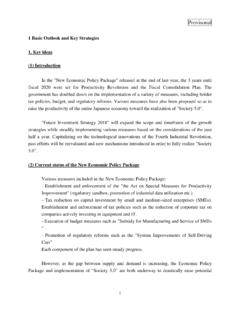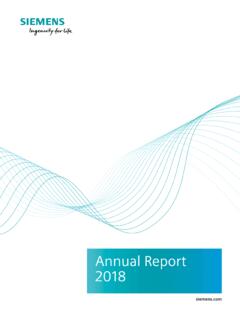Transcription of Tackling the digitalization challenge: how to benefit from ...
1 ISSN (print):2182-7796, ISSN (online):2182 -7788, ISSN (cd-ro m):2182-780X. Available online at Tackling the digitalization challenge: how to benefit from digitalization in practice P ivi Parviainen Jukka K ri inen VTT Technical research centre of Finland Ltd VTT Technical research centre of Finland Ltd. Tietotie 3, Espoo, 02044 VTT Kaitov yl 1, 90571 Oulu Finland Finland Maarit Tihinen Susanna Teppola VTT Technical research centre of Finland Ltd. VTT Technical research centre of Finland Ltd. Kaitov yl 1, 90571 Oulu Kaitov yl 1, 90571 Oulu Finland Finland Abstract: digitalization has been identified as one of the major trends changing society and business.
2 digitalization causes changes for companies due to the adoption of digital technologies in the organization or in the operation environment. This paper discusses digitalization from the viewpoint of diverse case studies carried out to collect data from several companies, and a literature study to complement the data. This paper describes the first version of the digital transformation model, derived from synthesis of these industrial cases, explaining a starting point for a systematic approach to tackle digital transformation. The model is aimed to help companies systematically handle the changes associated with digitalization .
3 The model consists of four main steps, starting with positioning the company in digitalization and defining goals for the company, and then analyzing the company's current state with respect to digitalization goals. Next, a roadmap for reaching the goals is defined and implemented in the company. These steps are iterative and can be repeated several times. Although company situations vary, these steps will help to systematically approach digitalization and to take the steps necessary to benefit from it. Keywords: digitalization ; digital transformation; systematic change; case studies; transformation method.
4 DOI: Manuscript received: 10 June 2016. Manuscript accepted: 13 March 2017. Copyr ight 2017, SciKA. General per missio n t o republish in pr int or elect ronic forms, but not for profit , all or part of t his mat er ial is gran t ed, provided t hat t he Int ernat ional Jour nal o f I nfor mat io n S yst ems and Pro jec t Manage ment copyr ight notice is given and t hat reference made t o t he publicat ion, t o it s dat e of issue, and t o t he fact t hat reprint ing pr ivileges were grant ed by per miss io n o f SciKA - Associat ion for Pro mot ion and D isseminat io n o f Scient ific Knowledge.
5 International Journal of Information Systems and Project Management, Vol. 5, No. 1, 2017, 63-77. 63 . Tackling the digitalization challenge: how to benefit f rom digitalization in practice 1. Introduction digitalization has been identified as one of the major trends changing society and business in the near and long term future [1]. The impact of digitalization will be major; it has been compared to the industrial revolution by several authors [2]-[5]. In this paper, digitalization is referred to as a more fundamental change than just digitizing existing processes or work products.
6 The term digitization refers to the action or process of digitizing; the conversion of analogue data (esp. in later use images, video, and text) into digital form. According to literature, digitalization , or digital transformation, refers to the changes associated with the application of digital technology in all aspects of human society [6]. digitalization is also known as the ability to turn existing products or services into digital variants, and thus offer advantages over tangible product [7],[8]. According to Brennen and Kreiss [9] digitalization refers to the adoption or increase in use of digital or computer technology by an organization, industry, country, etc.
7 The Finnish Tax Administration exemplifies the difference of digitizing and digitalization in the taxing of citizens; if the Tax Administration would have digitized their process, they would have implemented the tax reporting form as a digital form instead of a paper form and enabled attaching receipts and certificates in an electronic format as well. Instead, the Tax Administration renewed the entire process so that the tax authority electronically receives tax information directly from employers, banks, and other income sources of citizens, then the Tax Administration sends taxing proposal form to the citizens.
8 If the proposal is correct, the citizen does not need to do anything. Based on previously introduced definitions, digital transformation is defined as changes in ways of working, roles, and business offering caused by adoption of digital technologies in an organization, or in the operation environment of the organization. This refers to changes at several levels, including the following: Process level: adopting new digital tools and streamlining processes by reducing manual steps;. Organization level: offering new services and discarding obsolete practices and offering existing services in new ways.
9 Business domain level: changing roles and value chains in ecosystems;. Society level: changing society structures ( , type of work, means of influencing decision making). This paper focuses on the first three levels: the process, organization and business domain levels of digitalization and especially on how companies can tackle the change and benefit from it. The potential benefits of digitalization are high; already by digitizing information-intensive processes, costs can be cut by up to 90 percent and turnaround times improved by several orders of magnitude.
10 In addition, replacing paper and manual processes with software allows businesses to automatically collect data that can be mined to better understand process performance, cost drivers, and causes of risk. Real-time reports and dashboards on digital-process performance permit managers to address problems before they become critical [10.] According to Sabbagh et al. [11] digitalization offers incremental economic growth; countries at the most advanced stage of digitalization derive 20 percent more in economic benefits than those at the initial stage. digitalization has a proven impact on reducing unemployment, improving quality of life, and boosting citizen access to public services.






